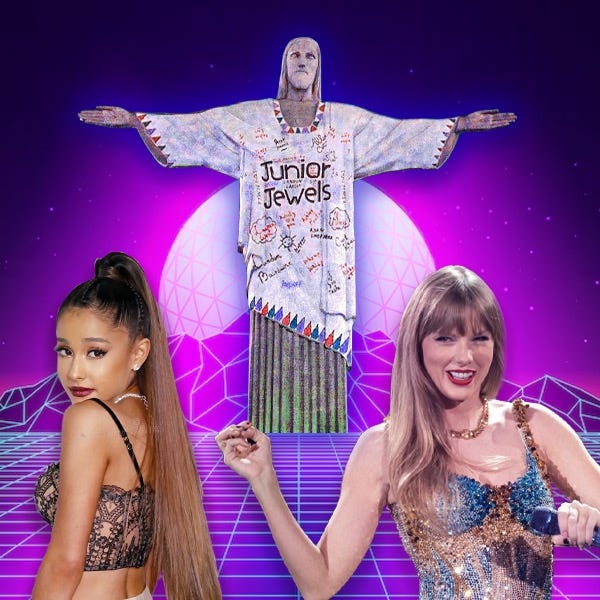As Taylor Swift prepared to bring the Eras Tour to Brazil, she was met with controversy as her fans launched a Twitter battle to get her tour t-shirt projected onto the Christ the Redeemer statue. The priest charged with making decisions about what gets to be projected onto the iconic statue that overlooks Rio de Janeiro received both desperate pleas and angry attacks from Swifties, as some accused him of hesitating to approve dressing the Savior in a “junior jewels” shirt due to his preference for Ariana Grande over Swift. In the end, the Swifties had their way, thus placing their idol among the ranks of the most revered deities in the universe.
It is surely understandable if Padre Omar was indeed a die-hard Arianator: Who can blame him for being partial to the culturally-Catholic Grande over Swift, whose upbringing was vaguely Protestant? Although neither pop star is overtly religious, their respective public personas and overall aesthetics speak to two vastly different cultural—even cosmic—paradigms.
And while both Swift and Grande are (technically…according to the contemporary usages of the term) both “white girls,” their public images speak to two distinct manifestations of “whiteness.”
Get a limited time 15% off discount to read this and other locked pieces.
“In this country, for a dangerously long time,” wrote James Baldwin, “there have been two levels of experience. One, to put it cruelly, can be summed up in the images of Gary Cooper and Doris Day, two of the most grotesque appeals to innocence the world has ever seen. And the other, subterranean, indispensable and denied, can be summed up, let us say, in the tone and in the face of Ray Charles.”
Baldwin was broadly speaking of an aesthetic dichotomy driven by race…yet his insight speaks to a greater discrepancy within American culture. His juxtaposition between the “grotesquely innocent” Day and the “subterranean” Charles sheds light on a metaphysical divide: between those who adhere to an “enchanted,” Dionysian sense of the universe—colored with passion, carnality, spontaneity—and those who see the world through a flattened Apollonian lens, for whom the universe is governed by orderly, rationalistic laws that are detached from the unpredictable, fleshiness of daily life. This juxtaposition encompasses a variety of social realities, including race and religion, as well as broader artistic and cultural sensibilities.
Swift is often mocked for being a poster child for archetypal “basic white girls.” Her style—both musically and aesthetically—is a reflection of her Anglo-Saxon roots, her “disenchanted” Protestant metaphysical foundation. A down-home girl who launched her career singing simple and sweet guitar-driven, country-tinged pop songs, Swift spoke to a particular experience of whiteness.
This is in part a matter of “nature”: her thin frame and pale complexion are a product of her Northern European genes. Her “unspicy” white DNA indubitably shapes her personality, musical style, and aesthetic. But part of it is a matter of “nurture”: I mean, how much chutzpah or sazón can you expect a white girl growing up in small(ish) town Pennsylvania to have?
For starters, the girl can’t dance. Bless her for trying, but as evidenced by the times she attempted to dance perreo to J. Balvin and merengue to Bad Bunny, Swift has no rhythm. While we must give her credit for managing to keep up over several trap beats during her 1989 era, her forays into hip hop were never really convincing. Take her parody song “Thug Story” performed with T-Pain at the 2009 CMA Awards, and the time she rapped along to “Trap Queen” on stage with Fetty Wap—Swift is painfully uncomfortable and out of her element.
Her non-ethnic whiteness is most poignant when she attempts, in vain, to throw shade. An artform mastered by sassy drag queens, fiery black women, sarcastic Jewesses, and combative Italian broads—each doing so with their own unique flavor—when white girls like Swift try their hand at it, it more often than not comes out as banal, cringe, and laughably awkward.
Grande’s capacity to throw shade is one among many reasons gay men fawn over her with more fervor, worship her with deeper reverence, than they do Taylor. No disrespect to the LGBTQ Swifties, but who can blame them for not measuring up to queer Arianators’ level of standom? On a purely pragmatic level, Ariana is the greater ally, with her frequent posts of pro-gay content on social media and her gender queer backup dancers…plus having a twink as a brother doesn’t hurt her case. Swift gets props for her “You Need to Calm Down” video…cringe and unimaginative as it was.
But Ariana’s cosmic orbit is more amenable to the “kids” for deeper metaphysical reasons…the same ones that likely drew Padre Omar to her over Taylor. Is it any wonder that queer art has a more intimate relationship (for better or worse) with Roman Catholicism’s imagery than with that of Protestantism? The affinity for paradox, for tension between opposing poles like sin and sanctity, the flesh and spirit, beauty and horror, glory and suffering in Catholicism—which was only further entrenched in Ariana by her proximity to Italian and queer cultures during her youth—harken to a social imaginary that is alien to most Swifties.
Writers of the ethnic white experience in America like Michael Novak and Camille Paglia emphasize how the upbringing of white kids like Swift and Grande vastly differ. Those growing up in Southern and Eastern European enclaves, wrote the Slovak-American Novak, are more accustomed to sudden surges of emotion—both of boiling anger and boisterous laughter, are committed to loyalty and togetherness over individuality and solitude, and are more at home in the gritty and earthy than in the pure and pristine.
Paglia similarly wrote about her experience in the WASP-dominated Ivy League of the 1970s, and her solidarity with non-Anglos (Italians, Jews, Blacks, Latinos) who were ostracized for their brash personality types. She spoke often of the strong Italian women who raised her, who both respected the “realm of the men” while also not being afraid to “put a man in his place”—a modus operandi she contrasted with the fragile, whiny tone of middle class suburban white girls, who in her eyes were perpetually complaining about their victimhood.
Grande’s nonna certainly fits Paglia’s characterization of Italian matriarchs, with her equal-parts warm and stern style of grandmothering and risqué sense of humor—having once joked about making a move on Jimmy Fallon before Ariana made an appearance on his show. And while growing up in Boca Raton, Florida is not exactly the same as growing up in Italy…it’s close enough—with its warm equatorial climate and presence of numerous Italian(-American) inhabitants.
Grande’s amalgam of dance-pop, R&B, trap, and Broadway/Disney-esque tunes speaks to the distinct cultural space she operates within. Taking her cues from the greats like Mariah Carey, Celine Dion, and Whitney Houston, Grande strives toward grandiosity (even if she never reaches it). She experiments with “big,” powerful, and tempestuously carnal sounds that are foreign to Swift’s repertoire and likely to intimidate her fans.
While I’m sure Swift has plenty of Italian fans…and numerous Italian-Americans enjoy country music, Italians tend to have more of an affinity for music whose origins come from the south rather than the north of them. The numerous Italians and Italian-Americans who listen to and make music rooted in the African diaspora—namely Jazz, House, and Disco—speak to the overlap between Mediterranean and African cultures—an overlap much more significant than that between Mediterranean and Anglo-Saxon/Nordic cultures. Not to mention the numerous Black musicians who use imagery from Italian mob movies…and the Black women who have a thing for Italian men.
It goes without saying that Grande is a notorious culture vulture, trying on other cultures as if they were outfits, and vapidly posturing her latest flavor of the month. Unlike other white girls who make Black music, she tries too hard—a perfect example of someone who appropriates rather than appreciates. She is distinct from others in her echelon like Amy Winehouse, Yebba, and Adele (who can dance to Dominican Dembow—a feat yet to be attempted by either Swift or Grande), who get respect for their engagement with Afrodiasporic artforms as they properly paying homage to their influences without reducing them to mere “costumes” or LARPs.
Grande twerks to trap music (on beat—might I add), speaks in AAVE, and brags about her weave. Her behavior is emblematic of the complicated relationships between Blacks and Italian-Americans. The same Italians who are quick to express their respect for Black entertainers and athletes—and to mock the blandness of “merigans” (Anglos)—haven’t been as quick to support the Black struggle for equality and, in some cases, harbor vehement prejudices against them.
Morally reproachable as Grande’s behavior may be, it is hard to deny that it’s a more convincing act than any of T Swizzle’s forays into blackphising. Grande’s personality and music overlap with non-white cultures in a way Taylor’s doesn’t. These two white girls belong to two different paradigms of whiteness, two different cosmic ambits which our rather limited contemporary discourses of identity struggle to grapple with.
Taylor deserves her flowers for her accomplishments. She is indeed a talented artist who has worked tirelessly to reach the heights of fame she’s soared to. But she surely doesn’t speak for all white people. And—perhaps because of this fact—she’s ultimately pretty vanilla.
For more on whiteness check out our review of You People, commentary on Rick Caruso, Mother Cabrini, and When Italians Became White, and our podcast discussions on the invention of whiteness with Bill Melone, White vs. Latin@ identity with Jeremy Klemin, and Blacks and Italians with Chloe Valdary.
Please consider signing up for a paid subscription to this page for more riveting content. If you’re new to Cracks in Pomo, check out the About page or read up on our Essentials. Also check out our podcast on Spotify, Apple, and YouTube and follow us on Instagram and Twitter.
MASA tortilla chips by Ancient Crunch is offering our followers 10% off their order with the promo code CRACKSINPOSTMODERNITY. Click here to redeem.
graphic by @wafers3d





